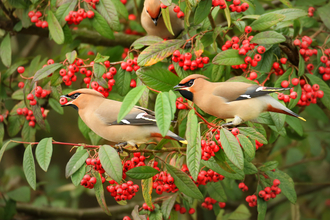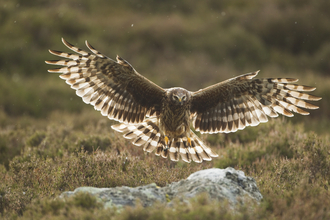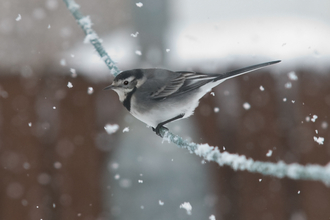Wintering wildfowl
Each winter our wetlands fill with wildfowl, a colourful collection of ducks, geese and swans escaping the harsh winters of their more northerly breeding grounds. Look for noisy flocks of teal and wigeon, elegant pintail and the bizarre-billed shoveler dabbling at the surface, or diving ducks like pochard, goldeneye and the scarcer smew surfacing for a few seconds before plunging beneath the water once more.
The air fills with the excited whistles of wigeon and teal, calling constantly as they dabble on the water’s surface.
Find wintering wildfowl
North
Cumbria Wildlife Trust
Foulney Island - This island nature reserve is a great place to spot wintering brent geese, or look for common scoter and long-tailed duck on the sea amongst the huge numbers of eider. Just remember the causeway can be submerged during high tide!
South Walney - In winter, huge numbers of waders and wildfowl feed and roost around the nature reserve, both on the intertidal areas and the gravel pools.
Northumberland Wildlife Trust
East Chevington - Two lakes provide a winter retreat for large numbers of wildfowl, including flocks of geese that can include scarcer species such as bean goose. This is one of four reserves on Druridge Bay, along with Cresswell Pond, Druridge Pools and Hauxley, all of which are fantastic places for birdwatching.
Grindon Lough - This natural lough, not far from Hadrian's Wall, is great for wildfowl, particularly during winter. A number of geese can be seen, including greylag, pink-footed, bean and white-fronted. Rarer visitors have included American wigeon.
The Wildlife Trust for Lancs, Manchester & N Merseyside
Wigan Flashes - The flashes, formed by mining subsidence, are a legacy of Wigan's industrial past. Now these lakes play host to a diversity of birds, with overwintering species including tufted duck, gadwall and goldeneye.
Yorkshire Wildlife Trust
Potteric Carr - Take advantage of the many hides to get close views of wintering wildfowl, including flocks of teal, wigeon and shoveler. You might even spot a bittern skulking in the reedbeds!
Midlands
Derbyshire Wildlife Trust
Willington Gravel Pits - In winter, large flocks of wildfowl gather, including wigeon, teal, pochard and shoveler.
Leicestershire & Rutland Wildlife Trust
Rutland Water - In winter, up to 28 species of wildfowl are recorded, often including good numbers of smew and goldeneye. Divers and grebes often spend the winter on the reservoir, too.
Lincolnshire Wildlife Trust
Gibraltar Point - Look out for flocks of brent geese grazing on the saltmarsh, or noisy skeins of pink-footed geese flying overhead. On the sea you might spot eider, common scoter and velvet scoter.
Whisby Nature Park - Visit Whisby in winter and you might witness the energetic display of the male goldeneye, throwing his head back and calling to nearby females.
Nottinghamshire Wildlife Trust
Attenborough - A complex of former gravel pits that attract large numbers of wintering wildfowl. An evening roost of goosander can involve dozens of birds.
Idle Valley - Several large lakes hold huge numbers of wintering wildfowl, such as wigeon, teal, pochard and goldeneye. This is also a good place to find red-crested pochard.
Staffordshire Wildlife Trust
Croxall Lakes - During the winter you will see a number of different species of wildfowl such as wigeon, teal or possibly smew
Warwickshire Wildlife Trust
Brandon Marsh - Wintering wildfowl include wigeon, teal and the occasional goldeneye.
Worcestershire Wildlife Trust
Upton Warren - Wintering wildfowl can be joined by bittern, water rail, and common and jack snipe.
East
Essex Wildlife Trust
Fingringhoe Wick - Thousands of waders and wildfowl feed on the estuary over winter, including flocks of brent geese.
Thurrock Thameside Nature Park - Opened in 2012, this huge, state-of-the-art park has a spectacular hide looking down onto Mucking Flats, used by thousands of dunlin and knot in autumn and winter. Also present in large numbers are other waders, ducks and gulls including bar-tailed godwit, teal, gadwall, pintail and avocet.
Herts and Middlesex Wildlife Trust
Tring Reservoirs - These four spring-fed reservoirs have some of the best birdwatching in southern England: flocks of lapwing, golden plover, goldeneye, wigeon, shoveler, tufted duck, goosander, gadwall and pintail can all be seen in autumn and winter.
Stocker’s Lake - A large lake in the Colne Valley, which attracts huge numbers of wintering wildfowl including spectacular mandarin ducks as well as shoveler, smew, pochard, wigeon and gadwall.
Amwell - This reserve is internationally important on account of the numbers of water birds that visit. In winter there are huge numbers of gadwall and shoveler and also tufted duck, pochard, teal and little grebe. Look out for flocks of lapwing.
Norfolk Wildlife Trust
Cley Marshes was purchased in 1926, making it the first Wildlife Trust reserve in the country. It is one of the best in Europe for birdwatching with many rare visitors. The shingle beach, saline lagoons, grazing marsh and reed bed support large numbers of wintering and migrating wildfowl and waders, as well as bittern, marsh harrier and bearded tit.
Hickling Broad - From October to March the raptor roost at Hickling Broad provides excellent views of raptors as they fly in to roost. You can see hundreds of marsh harriers – a bird which remains rarer than golden eagles as a British breeding species - hen harriers, merlin and barn owl. It is also possibly the best place in Britain to view wild common cranes.
Suffolk Wildlife Trust
Lackford Lakes - A former gravel pit complex by the river Lark, consisting of meadows, woodland, reedbeds and streams. Superb for wildfowl in both winter and summer, Lackford attracts tufted duck, teal, pochard, gadwall, shoveler and goosander. The large winter gull roost can number 28,000.
South
Hampshire and Isle of Wight Wildlife Trust
Blashford Lakes - A series of former gravel pits attract large numbers of wintering wildfowl, including up to 900 gadwall. On winter evenings, dozens of goosander fly in to spend the night roosting on the water.
Farlington Marshes - One of the Trust's oldest reserves, which comes alive in winter as it plays host to huge numbers of wildfowl. There are thousands of dark bellied brent geese, wigeon and teal, as well as wading birds like avocet, redshank and dunlin.
Kent Wildlife Trust
Oare Marshes - This mosaic of wetland habitats, including grazing marsh and reedbed, is of international importance for overwintering wetland birds.
Somerset Wildlife Trust
Catcott Complex - Internationally important numbers of ducks including wigeon, pintail, shoveler and teal rub up against each other on the flooded fields while waders such as lapwing and snipe pick their way around the drier land. Also watch for Bewick’s swans, golden plover and whimbrel.
Sussex Wildlife Trust
Rye Harbour - Shingle, saltmarsh, sand dunes, rivers, pits, grazing marsh, reedbeds and farmland make this a great place to see a wide variety of wildfowl and wading birds, including brent geese, wigeon, teal and shoveler.
Wiltshire Wildlife Trust
Langford Lakes - Many ducks, including tufted duck, pochard, gadwall, shoveler, wigeon, goosander and goldeneye use the lakes as wintering grounds. You might also spot an elusive bittern.
Wales
Radnorshire Wildlife Trust
Llanbwchllyn - In winter this reserve is important for wintering ducks, with mallard, teal, tufted duck and pochard commonly seen, though goldeneye is now a rare winter visitor.
Pwllpatti - A bird hide overlooking an old ox-bow of the River Wye which floods in winter, attracting the largest wigeon roost in Powys. You could also see tufted duck, coot, mallard, little egret, teal and occasionally pochard and gadwall.
The Wildlife Trust of South & West Wales
Teifi Marshes - One of the best wetland sites in Wales, attracting large numbers of wintering wildfowl like teal and wigeon. Water rail, snipe, curlew and lapwing are also regular winter visitors.
Scotland
Montrose Basin - Tidal basin with mud, fresh and salt water, saltmarsh, reedbed and grassland. Pink-footed geese numbers peak in October, with a record count of 90,000, before trailing off in November, though some are present throughout winter. There are also usually about 2,000 overwintering redshank and eider, 3,000 wigeon, 4,000 oystercatchers and perhaps even more knot.
How to do it
Wrap up warm and head to your local wetland with a pair of binoculars. Ducks are usually much easier to spot than most birds, but rarer species can be hidden amongst flocks of common visitors. Diving ducks like goldeneye and smew are easily overlooked, as they sometimes only surface for a few seconds between dives, so keep scanning!
If you can't get to these places
Almost any large body of water can attract wintering wildfowl, so check your Wildlife Trust’s website to find a suitable reserve near you. The goosander, an elegant saw-billed diving duck, sometimes spends the winter on urban rivers and canals.
More wildlife experiences
From seeing colourful wildflowers to spotting magnificent birds of prey, we can help you get closer to wildlife across the UK.










